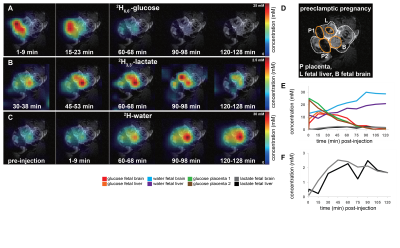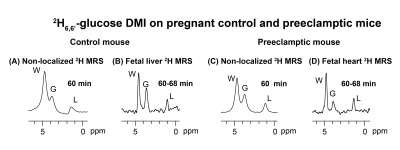Stefan Markovic1, Tangi Roussel2, Michal Neeman3, and Lucio Frydman1
1Department of Chemical and Biological Physics, Weizmann Institute of Science, Rehovot, Israel, 2Center for Magnetic Resonance in Biology and Medicine, Marseille, France, 3Department of Biological Regulation, Weizmann Institute of Science, Rehovot, Israel
1Department of Chemical and Biological Physics, Weizmann Institute of Science, Rehovot, Israel, 2Center for Magnetic Resonance in Biology and Medicine, Marseille, France, 3Department of Biological Regulation, Weizmann Institute of Science, Rehovot, Israel
The fate of 2H6,6’-glucose in
pregnant controls and preeclamptic mice was followed by Deuterium Metabolic
Imaging. Lactate was produced in placentas and fetal organs, and its levels
were elevated and washed out more slowly in the case of preeclamptic
pregnancies.

DMI
data collected at the indicated stages following the intravenous administration
of 2H6,6’-glucose to a preeclamptic pregnant mouse. Metabolic
maps of 2H6,6’-glucose (A) and its metabolic products 2H3,3’-lactate
(B) and 2H-water (C) are here shown for illustration purposes. The
anatomical 1H image on top of which all 2H data are shown
is depicted in (D). Time traces for all metabolites (E) and a zoom into lactate
traces (F) are shown for the entire time series.

2H MRS
and MRSI spectra arising after intravenous administration of 2H6,6’-glucose
to pregnant preeclamptic and control mice. The columns A and C present
non-localized spectra from the 2H MRS and organ-specific 2H
spectra localized from the MRSI data (B, D) at similar post-injection
time-points. Signals for 2H6,6’-glucose and its metabolic
products water and lactate are indicated by letters G, W and L respectively.
